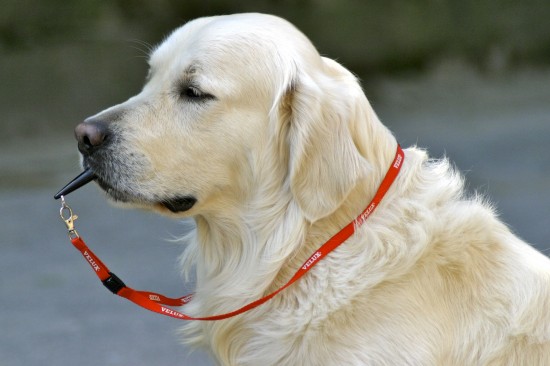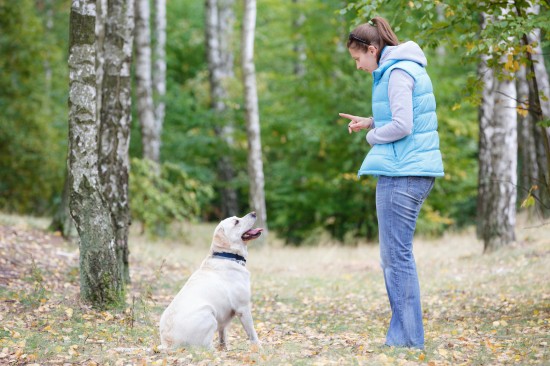

You have probably heard of the silent whistle or the Galton whistle as a dog training aid, although they are not as widely used today as they have been in the past.
A silent whistle isn’t exactly silent per se; it is just that the sound that it produces cannot be heard by the human ear! The hearing of the dog covers a different range of sounds to human hearing, and they have a particularly keen attenuation for high sounds that are outside of the range of what we as people can detect. So when a silent whistle is blown, the people around you will not bat an eyelid, but your dog can certainly hear it, and come to recognise different whistle tones and patterns for different commands.
Are you wondering if training your dog to respond to a silent whistle is a good idea for you, or how to go about it? Read on to find out more.
A whistle is essentially a tube, with a reed or ball within it that creates the sound caused by blowing through it. The shorter or narrower the tube of the whistle, the higher pitched the tone that it creates it will be. This is why silent whistles are short; they are designed to work with high-range tones, rather than to make a deep or loud noise. The sound created by a silent whistle is so high pitched that only your dog can detect it, and so, it catches their attention.
Silent whistles should be used with care, as due to the fact that you cannot hear the sound that you are producing, you will not be able to judge how shrill or deep it is. Blowing too near to your dog, or too hard, can actually prove painful to your dog’s ears, so use your silent whistle with care.
The range of sound that people can hear goes up to around 23,000 hertz, and silent whistles are designed to produce sounds in the 23,000 to 45,000 hertz range. This means that when you blow the whistle, all you will hear produced is the sound of the air passing through the whistle, but your dog will hear a clearly defined tone. This means that you can use the whistle in close proximity to other people when training your dog without disturbing them; but bear in mind that other people’s dogs will also be able to hear the whistle, and may find it confusing, so take this into account!
Because the tone of the whistle is fairly unusual and not a sound that many other things produce, it is an effective way of getting your dog’s attention, and recalling them to you. It is much more neighbour-friendly than walking round the garden or urban areas yelling for your dog at the top of your voice, and the range travels further than the average yell too!
Firstly, it is important to establish that your whistle is audible to your dog, and causes them to react and look to you when they hear it. Practice this before you attempt to train your dog using the whistle, by using it to get their attention and try out different sounds and patterns of blowing in the whistle to ensure that it is effective.
This can be a little odd for the first time whistle user to get used to, as you will have to take all of your cues from your dog’s responses, rather from the feedback of the sounds you can hear yourself making!
There are a variety of different ways in which you can use the whistle, as part of your dog’s everyday training and commands, or in specific situations.
A whistle can be really useful if your dog tends to roam out of your sight or take off on chases when out walking, due to the distance over which the sound of the whistle will carry. So you may simply wish to use the whistle to recall your dog only, or to use when your dog is outside of the range of hearing that you can achieve with your voice.
You can also establish and utilise a great many different sounds with the whistle, by using a combination of longer and shorter blows, and patterns of blows in series. Exactly how many different sounds your dog will be able to recognise, retain and act upon will very much depend on your own particular dog, their intelligence and responsiveness.
Once you start working on commands with your dog using the whistle, it is important to keep your tones consistent. It is a good idea to make yourself a list of say, five basic tones and their corresponding commands to begin with, and use this is a chart to follow, in order to ensure you do not send mixed signals to your dog.
After that, the sky really is the limit!
 Why I Have a Horse
Why I Have a Horse
 Is The Welsh Terrier A Good Choice Of Pet?
Is The Welsh Terr
Is The Welsh Terrier A Good Choice Of Pet?
Is The Welsh Terr
 Give your birds the perfect protection habitat in chicken coops
Give your birds the perfect protection habitat in chicken
Give your birds the perfect protection habitat in chicken coops
Give your birds the perfect protection habitat in chicken
 The Large And Lovely Newfoundland Dog
The Large And Lov
The Large And Lovely Newfoundland Dog
The Large And Lov
 Addressing Learned Irrelevance When Training The Dog
Addressing Learne
Addressing Learned Irrelevance When Training The Dog
Addressing Learne
Copyright © 2005-2016 Pet Information All Rights Reserved
Contact us: www162date@outlook.com